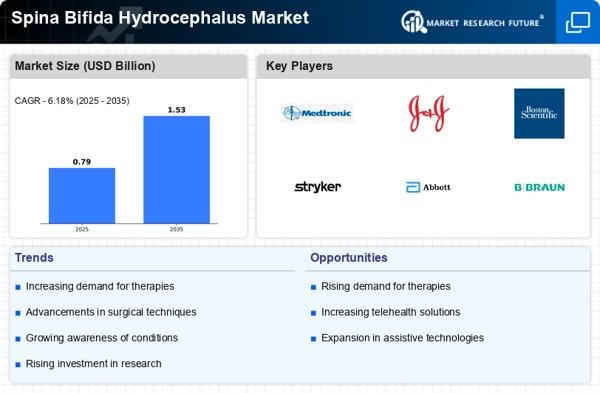Advancements in Medical Technology
Technological advancements in medical treatments and devices are significantly influencing the Spina Bifida Hydrocephalus Market. Innovations such as minimally invasive surgical techniques, improved imaging technologies, and advanced shunt systems have transformed the management of these conditions. For instance, the development of programmable shunts has enhanced the treatment of Hydrocephalus, allowing for better patient outcomes. The market for these advanced technologies is projected to expand, with estimates suggesting a compound annual growth rate of over 5% in the coming years. This growth is indicative of the increasing reliance on cutting-edge medical solutions within the Spina Bifida Hydrocephalus Market.
Increased Government Funding for Research
Government funding for research into Spina Bifida and Hydrocephalus is a significant driver for the Spina Bifida Hydrocephalus Market. Various health departments and agencies are allocating resources to study the causes, treatments, and long-term outcomes of these conditions. This funding is essential for fostering innovation and developing new therapies, which can lead to improved patient care. For example, recent initiatives have focused on genetic research and prenatal screening, which may reduce the incidence of these conditions. The ongoing commitment of governments to support research efforts is likely to enhance the overall landscape of the Spina Bifida Hydrocephalus Market.
Growing Support from Non-Profit Organizations
The role of non-profit organizations in raising awareness and providing support for individuals with Spina Bifida and Hydrocephalus is a crucial driver for the Spina Bifida Hydrocephalus Market. These organizations often engage in advocacy, education, and fundraising efforts, which contribute to increased public awareness and understanding of these conditions. As awareness grows, so does the demand for medical services and products tailored to these patients. The financial support and resources provided by these organizations can lead to enhanced research and development initiatives, further propelling the market forward. This synergy between advocacy and market growth is vital for the Spina Bifida Hydrocephalus Market.
Rising Demand for Comprehensive Care Solutions
The increasing recognition of the need for comprehensive care solutions for individuals with Spina Bifida and Hydrocephalus is driving the Spina Bifida Hydrocephalus Market. Patients often require multidisciplinary care that encompasses surgical, medical, and rehabilitative services. This holistic approach is gaining traction among healthcare providers, leading to the development of integrated care models. As healthcare systems evolve to meet these needs, the demand for specialized services and products is expected to rise. This trend indicates a shift towards more patient-centered care, which is likely to have a lasting impact on the Spina Bifida Hydrocephalus Market.
Rising Incidence of Spina Bifida and Hydrocephalus
The increasing incidence of Spina Bifida and Hydrocephalus is a notable driver for the Spina Bifida Hydrocephalus Market. Recent data indicates that approximately 1 in 1,000 births are affected by Spina Bifida, while Hydrocephalus affects around 1 in 500 births. This rising prevalence necessitates enhanced healthcare services and treatment options, thereby expanding the market. As more infants are diagnosed with these conditions, the demand for specialized medical interventions, including surgeries and ongoing care, is likely to grow. This trend suggests a sustained need for innovative solutions and therapies within the Spina Bifida Hydrocephalus Market, ultimately driving market growth.

















Leave a Comment